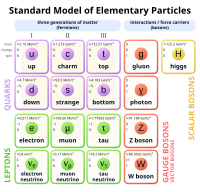
Photo from wikipedia
ABSTRACT Runners are commonly modeled as spring–mass systems, but the traditional calculations of these models rely on discrete observations during the gait cycle (e.g. maximal vertical force) and simplifying assumptions… Click to show full abstract
ABSTRACT Runners are commonly modeled as spring–mass systems, but the traditional calculations of these models rely on discrete observations during the gait cycle (e.g. maximal vertical force) and simplifying assumptions (e.g. leg length), challenging the predicative capacity and generalizability of observations. We present a method to model runners as spring–mass systems using nonlinear regression (NLR) and the full vertical ground reaction force (vGRF) time series without additional inputs and fewer traditional parameter assumptions. We derived and validated a time-dependent vGRF function characterized by four spring–mass parameters – stiffness, touchdown angle, leg length and contact time – using a sinusoidal approximation. Next, we compared the NLR-estimated spring–mass parameters with traditional calculations in runners. The mixed-effect NLR method (ME NLR) modeled the observed vGRF best (RMSE:155 N) compared with a conventional sinusoid approximation (RMSE: 230 N). Against the conventional methods, its estimations provided similar stiffness approximations (−0.2±0.6 kN m−1) with moderately steeper angles (1.2±0.7 deg), longer legs (+4.2±2.3 cm) and shorter effective contact times (−12±4 ms). Together, these vGRF-driven system parameters more closely approximated the observed vertical impulses (observed: 214.8 N s; ME NLR: 209.0 N s; traditional: 223.6 N s). Finally, we generated spring–mass simulations from traditional and ME NLR parameter estimates to assess the predicative capacity of each method to model stable running systems. In 6/7 subjects, ME NLR parameters generated models that ran with equal or greater stability than traditional estimates. ME NLR modeling of the vGRF in running is therefore a useful tool to assess runners holistically as spring–mass systems with fewer measurement sources or anthropometric assumptions. Furthermore, its utility as statistical framework lends itself to more complex mixed-effects modeling to explore research questions in running. Summary: A new method to estimate the spring–mass characteristics of runners is presented using nonlinear regression techniques with vertical ground reaction force recordings, which yields spring-mass parameter sets that produce more stable simulated running.
Journal Title: Journal of Experimental Biology
Year Published: 2021
Link to full text (if available)
Share on Social Media: Sign Up to like & get
recommendations!